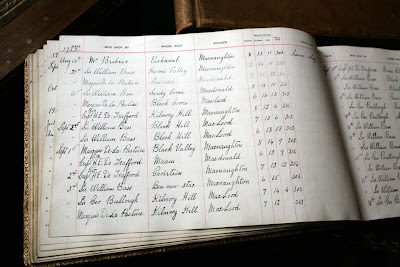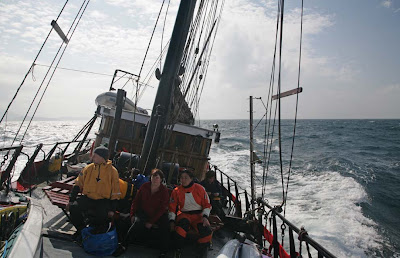
Rockpool Alaw Bach at Coldingham, Cailean.
This test is based on a test which first appeared in
UK Paddles magazine in September 2005. I owned a Rockpool Alaw from April 2005 until February 2006 and have owned a Rockpool Alaw Bach since September 2005.

Alaw Bachs on the Solway, Richard and Kenny.
IntroductionAlthough “
Rockpool Kayaks” are relatively new to the kayaking world, the boats are designed and built in Wales by two of the most respected people in UK sea kayaking - Aled Williams and Mike Webb. At first sight their kayaks stand out for two reasons: the originality of the design and the quality of construction and finish.

Alaw Bach with Alaw behind, on the Solway.
The Rockpool Alaw and Alaw Bach are designed as mid volume touring boats, to be fast, comfortable, manoeuvrable and seaworthy in rough water. The two designs share the same hull shape but have different deck and cockpit profiles. The Alaw is for larger paddlers, with longer legs or thicker thighs. It has a raised cockpit rim, which allows extremely comfortable, knees up, paddling position. This gives excellent control over edging (tilting the boat laterally to assist manoeuvrability and turning). The Alaw Bach has a more conventional, lower cockpit rim for smaller paddlers, but shares the same hull as the Alaw. The edge of the cockpit rim is rather sharp and I have now cut through two neoprene spray decks, at the front near the handle. Both Rockpools have relatively aggressive thigh braces and a choice of two seat widths is available.
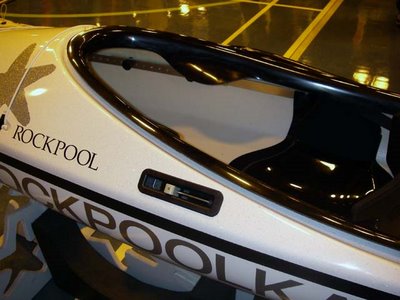
Alaw Bach cockpit and thigh braces. Note optional skeg control.

Alaw in the MacCormaig Islands, Sound of Jura.

Emily disengages the Alaw's "skeg" and shortens waterline length by edging.
Both boats have chines or edges in the cockpit area. The flattish bottom gives good surfing performance; it also gives good primary and secondary stability and allows radical edging for manoeuvrability. At the bow the edges run out into a more rounded bow section, which carries its volume fairly far forward then finishes in a V section. This reduces nose-diving in following seas and pitching in head seas. The stern tapers into a thin skeg shaped keel. This increases waterline length for speed and tracking, but as it can come out of the water, with forward weight distribution and edging, it does not hinder manoeuvrability. The hull shape and snug cockpits mean these boats are designed to give excellent control of edging.

An Alaw's perfect moulding reflects the waves.

Alaw in the Inner Sound, Skye, Harvey.
The Alaw and Alaw Bach are designed primarily for experienced kayakers, to be used in rough water. However, due to their stability they are also good for novices in calm conditions.

Alaw Bachs in Loch Nevis, Mike.
My GPS shows I have now covered over 300km in the Alaw and Alaw Bach, from the Summer Isles in the North, to the Skye symposium, to Arisaig, to the Garvellachs area, to the Clyde and to the Solway further south. It has been loaded with gear for four nights camping and used unloaded. Paddled in flat water and confused water, from no wind up to force 6. (Since this test was written in late June 2005 I have covered a further 1700km in both Rockpools.)

Alaw Bach and Valley Skerray in the Sound of Jura, Jennifer and Billy.
Other testers’ weights ranged from 55 to 90kg and experience levels ranged from novices to 5 star and aspirant level 5 sea paddlers and coach.
Both kayaks were paddled alongside and compared with 2004 and 2005 P&H Quests, a 2004 P&H Sirius, a 2005 Valley Nordkapp Jubilee, a mid 1980’s Nordkapp HM, a Valley Avocet, and an older Valley composite Skerray, Since the test was published I have paddled both Alaw and Alaw Bach extensively alongside both the Valley Nordkapp LV and the P&H Quest LV
Construction and finish.
Glitter finish and trademark starfish.

Close up of glitter.
Both Rockpool kayaks have a better quality of finish than either the 2005 Quest or the 2005 Nordkapp Jubilee. This applied particularly to the hull moulding. In a low sun the Rockpool hulls had a ripple free finish. The Quest and Jubilee both had ripples across the hull where different sections of glass matting had been overlaid. Other details such as the gel coats on the Rockpool boats were outstanding. A glitter finish with a clear gel coat is available in the standard price. Without wanting to sound too sexist, I think this may well be the thing that attracts more women and girls into sea kayaking than anything else! In comparison, the 2005 Quest had a defect in the deck gel coat, which had been filled at the factory and the 2005 Jubilee deck looked dull and as if it had uneven pigment. The fittings on the Rockpool boats were accurately located. The seat in the 2005 Quest was mounted three centimetres too far forward on one side. In the Jubilee, one side of the seat was one centimetre further forward than the other. (Both P&H and Valley changed ownership in 2005 and since this test was written I have had the opportunity to paddle a number of 2006 P&H and Valley kayaks and their finish and outfitting has been faultless.) Unlike Valley and P&H boats, the Rockpool is not available with a compass recess.

Recessed deck fittings for deck lines.
The Rockpool deck lines are retained by flush plates bonded over the deck recesses with a high tech adhesive. This is a very nice original design, though as with any new solution, only time will prove reliability. (Since this test was first published, some of the original composite plates, which matched the deck colour, have come off. The cause was delamination of the composite plate rather than the adhesive failing. Current boats have a plastic plate and as far as I have heard, none have failed.) Although the deck lines appear the same as P&H and Valley lines, they stretch more when wet. The deck elastics that retain paddle shafts are adjustable with a plastic clamp that slides over a generous loop of elastic. In contrast the tiny piece of elastic on a Valley Nordkapp LV was cut so short that it had insufficient stretch to accommodate a paddle shaft!

Deck elastics with adjuster, deck line fittings and heavy duty KayakSport rubber hatch cover. This boat has been fitted with an aftermarket Kari-Tek Hydro Skeg.

Adjustable foot plate and rack. Note the Rule 500 gallons/hour electric pump which I have fitted to my own Alaw Bach.

The combination of seat, thigh grips and footplate in the Alaw must make this THE most ergonomic cockpit!
The Rockpools have an adjustable footplate. This is anatomically angled for the most comfortable ankle position and is cut away at the heels to allow stretching of the legs. It is very easy to adjust, works faultlessly and more boats should have one. It was superior to the Yakima style peg footrests fitted by P&H and Valley.

An Alaw fitted with the wide seatpan.
The seat has the lowest fitting I have seen in any kayak, this gives a low centre of gravity, which aids stability. I wish more kayak seats were like this. The seat is available in two widths and has neoprene pockets at the sides into which foam shims can be placed to quickly customise the fit for different paddlers. One of the foam pockets on the test Alaw became unstuck but was easily refitted with contact adhesive. The seat is mounted far forward in the cockpit with a lot of dead space behind it. It makes it easy to layback but I wonder if it would not have been better to minimise the cockpit volume by making it end just behind the seat.

Jennifer takes a rest on the Alaw's aft deck.
(Since the test was published Rockpool now supply the seat on two aluminium slider bars. Holes drilled in these locate on the two bolts which also secure the footrest adjustment bars. This allows the seat to be moved forward and back. I have found moving the seat to near the back of its adjustment gives me the best level trim, without sinking the tail. ) The bolts for the seat/footrest adjustment bars are moulded into the hull with no holes drilled through the hull as in P&H and Valley boats. However, I know one owner whose bolt became detached. It was promptly fixed by Rockpool.
The backrest is a simple affair, supported by a lot of thin elastic cord. It provides perfect back support and encourages a forward stance. It tends to fold under your bum when doing re-entry rolls and the cord was showing serious signs of wear after a few months. As it is threaded through the seat back, it did not look easy to replace. In comparison, both the new style high back (plastic seat) and traditional low back Quest (GRP seat) seat backs are less comfortable, and the high back severely restricts wet re-entries. The Quest seat back is not supported by elastics, but by a tab that fits in a slot in the seat base. These have broken off on several Quests fitted with the GRP seat. The Valley seat back was substantial, comfortable and had no signs of wear.
The hatch covers are the new lightweight, floating KayakSport design with plastic centres. They were easy to fit and remove and all three compartments on both boats remained totally dry, even after extensive “wet work”. The 2005 Quest had the heavier KayakSport all rubber covers, which proved easy to use. The Jubilee had heavy VCP covers, which were extremely awkward to fit properly, even with warm hands. Both the Quest and Jubilee had a small dribble of water in the rear compartments, possibly from where the skeg wire enters the box. The Rockpool boats have round hatch covers front and rear, which makes loading large items awkward. We had to remove the poles from a tent bag. However, the stern compartments are surprisingly commodious due to the lack of skeg boxes. As expedition boats, the Jubilee has oval front and rear hatches and the Quest has an oval rear hatch, which makes loading bulky items much easier. Until late 2006, bulkheads were cut from GRP sheet then laminated into place with GRP. Unlike P&H there is no small air hole drilled in the bulkhead. Several owners of dark coloured boats have lost their hatch covers when the boats have been on car roof racks on sunny days and air inside the compartment has expanded. (From 2006 Rockpool supply heavy rubber fore and rear hatch covers but the lightweight one is still supplied for the day hatch.)
As the Alaw and the Alaw Bach are mid size boats, targeted at day trips (and the Alaw Bach is recommended for small to mid size paddlers), I expected them to be light. However, although the quoted weight is 22kg, the dry weight of the Alaw was 26.5kg and that of the Alaw Bach was 26.0kg. Both were measured on Salter medical scales. In comparison, a Quest with Kevlar keel strip, compass, towing hardware, built in electric bilge pulp and lead acid battery was only slightly heavier at 28.5kg. So if you are having difficulty lifting boats onto a roof rack, check that you can lift a Rockpool boat as part of your demo. Rockpool do not fit exterior keel strips but if you examine the hull in strong sunlight you can see extra internal reinforcement along the keel line. If you press the hull of a P&H or Valley boat in the cockpit area the hull flexes considerably. This does not happen in a Rockpool. (From October 2006 Rockpool are fitting their new lightweight plastic bulkheads. These are dished at the edges and have a layer of foam between the edge and the hull and deck. On the cockpit side, there is an additional Sikaflex seal. These bulkheads cut 0.75kg weight and should also solve the problem of gel coat crazing which can affect many older boats (from all manufacturers) with traditional bulkheads.)

Alaw Bach demonstrating robust construction in the Cuan Sound, Richard.
Performance.
Alaw Bach in the Cuan Sound, Kenny.
Given their identical hull shapes, the majority of comments relate equally to both the Alaw and Alaw Bach,. The Alaw’s paddling position is superb, giving all day comfort, but maintaining positive control for edging and balance. If you look at the shading on the bow photographs, you will see that the Rockpools carry their volume well forward. This is good for paddling into short steep waves and unlike the Quest (which has a very fine bow) it does not dip its bow. However, unlike an unladen Nordkapp Jubilee, it does not throw its bow high in these conditions. A highlight of its performance was in a spring ebb tide against a force 5 wind with standing waves in a Solway tidal channel. Fantastic stuff! It picks up following waves more easily than any other boat I have paddled. It can be steered on a wave by using edging or stern rudder strokes. It is less likely to broach or nose dive than a Quest or Nordkapp/ Nordkapp LV. However, at the limit of my ability in the surf, I ultimately found the round hull of the Nordkapp LV more forgiving. On several occasions I caught an edge in the Rockpool and capsized. Paddlers crossing into sea kayaks from river boats designs with edges should not find this a problem. I also found the Nordkapp LV easier to straighten up from a broached position as the surf reformed when it approached the shore after crossing a bar.

Alaw Bach at Coldingham, Cailean.
Edging shortens waterline length and disengages the skeg part of the keel. This increases manoeuvrability. It was more responsive to steering by edging than the Nordkapp Jubilee and the Sirius and much more so than the Quest. Unlike the Quest, which is unstable when edged enough to turn, the Alaw (also Alaw Bach) remains stable while edging. Recent converts from white-water paddling felt right at home in these boats. At the other end of the scale, several beginners also liked the boat. Indeed, learning to steer by edging is so easy that it gives novices a real sense of achievement in their first days of paddling. They also appreciated its primary stability as I did, for photography. I could take good photos from the Alaw (also Alaw Bach) but as it slowed, it tended to veer to one side due to lack of a skeg.
At first I thought the narrow extension at the stern was designed to be a skeg to control weather cocking, but at rest, when not loaded with camping gear, it barely sits in the water. As you build up speed the boat squats back and it engages slightly in the water, not enough to act as a skeg but enough to increase the waterline length for good boat speed.
On a windless day at slack water, the following boats’ maximum sprint speeds were measured using a Garmin GPSmap76cs (with WAAS/EGNOS enabled giving 2m accuracy: Alaw Bach: 10.1km/hr, Quest LV: 10.6km/hr, Quest: 10.6km/hr, Nordkapp RM 9.9km/hr, Nordkapp LV: 11.5km/hr.
All sea boats roll well, but the Rockpools and Nordkapp LV rolled more easily and quickly than either a Nordkapp Jubilee or a Quest. With its low rear cockpit rim, the Alaw Bach particularly lends itself to back deck rolls. After a re-entry roll, surprisingly little water enters the Rockpool cockpit but several Rockpool owners have further reduced cockpit volume by putting airbags in front of the footplate and either an airbag or minicell foam block in the space behind the seat. A flooded Rockpool is more difficult to paddle than a flooded Quest after a self rescue. The Alaw Bach is slightly more difficult to wet exit than the others if you have bulky thighs but a re-entry roll is easier due to the firm fit in the cockpit.
Although primarily a day boat design, both Rockpools continue to perform well when loaded for camping trips. The feeling of stability on rough water when loaded is very reassuring. Due to the shape and rocker of the bow, a loaded Rockpool is more difficult for a rescuer to turn upside down to drain in a T rescue than a Nordkapp LV. 85kg+ paddlers do not have a great deal of free board when fully loaded so they need to have a well fitting spraydeck. Several lighter paddlers felt the tendency to weathercock was less when loaded.

Alaw, Alaw Bach and Nordkapp LV on camping trip to Gigha.
Performance in difficult conditions.The Rockpool Alaw Bach is a great rough water play boat and in that role does not need a skeg. However, if you are using it on longer crossings, with the wind from the rear quarter, then it does weather cock. A skilled paddler will compensate by edging, using intermittent stern rudder strokes and sliding the paddle shaft to the upwind side for more leverage. Up to force 3-4 you can control it by edging but after seven km or so this gets rather tiring, especially if you have bad joints like me. As most of the built in "skeg" remains above the water, its windage may contribute to this performance characteristic. At the top end of force 4 into force 5 it sometimes responds to edging the wrong way. I did not notice weather cocking in rough water.
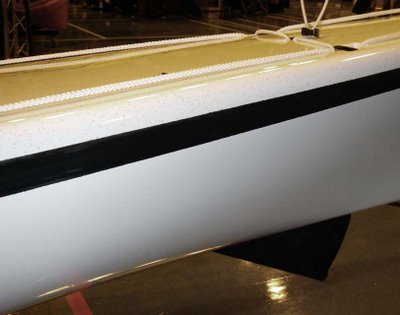
Rockpool optional skeg was introduced in late 2006.
Rockpool now offer a small skeg as an option and
Kari-tek can supply and fit their Hydro Skeg as an aftermarket fitment. The Hydro Skeg has transformed the Alaw Bach for my wife (who paddles it most) but I also benefit from it. The Rockpool can be trimmed to paddle straight using varying amounts of skeg, regardless of wind strength or direction. I have never had to use the standard Hydro Skeg in the fully down position in the Rockpool.
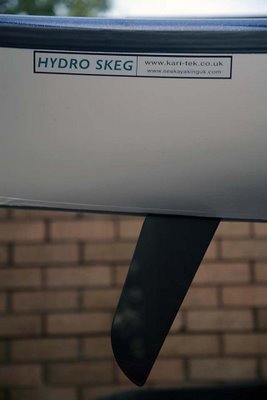
Kari-Tek's Hydro Skeg in fully down position. I have never had to use the Hydro Skeg in this position in the Alaw Bach.

This is as much of the Hydro Skeg you ever need to use on a Rockpool.
In force 6 winds and above both Rockpools have a tendency to lee cock and like some other boats (eg the Point 65 XP) may be easier to turn by pointing the bow downwind rather than bringing the bow round through the wind. At the mouths of Scottish sea lochs you get steep waves on an ebb tide against the wind. Paddling into wind and waves in these conditions the bows of the Rockpool and the Valley Nordkapp Jubilee tended to throw up high and get blown downwind. The Nordkapp LV does this to a much lesser extent and the Quest tends to keep its bow low in waves, often dipping into them. It seems to be less affected by lee cocking in these conditions than the other boats.
The Rockpools are outstanding boats on moving water in tidal channels, races and overfalls. As long as you lift your upstream edge when leaving an eddy and entering a tidal flow, this boat will look after you. It gives a very secure feeling in overfalls when those nasty pyramids of water leap up at you, with little warning.

Alaw Bach in a 23km/hr race, Kenny.

Alaw Bach in the Corryvreckan at slack water, Mike. This did not last long!
The clincher!On a recent paddle back from the west coast of Scarba, through the Grey Dogs, in a force 6 north easterly, the gusts were more than 30mph. The water conditions were confused. The west flowing flood, jetting out of the Grey Dogs, was against us along the north of Scarba. It was steepening up the Atlantic swells, which were coming from behind. The wind blown chop was coming from the port fore quarter and the clapotis was coming at us from every angle to starboard. I have never been in a boat that handled such difficult conditions as well as the Alaw. I put a lot of this down to the superb ergonomic positioning of the seat, the footplate and the very positive grip of the thigh braces. After the test I bought an Alaw, not to replace my Quest expedition boat but to compliment it. Lots of river paddlers have more than one boat. Will this also become a trend for sea paddlers?
The Alaw Bach.
Alaw Bach in the Solway, Douglas.
The hull shape is the same as the Alaw, but with a more conventional cockpit arrangement. I found the lower cockpit a bit snug for my large diameter thighs but it gave a very secure paddling position While I managed whole day paddles in the Alaw with absolutely no discomfort, I found I was getting a bit stiff after a half day in the Alaw Bach. I did have to consciously “wet exit” by doing one leg at a time. I found it even easier to do a re-entry roll than in the Alaw. It was like having the security of an ocean cockpit in a Nordkapp HM but was much easier to get in and out of. Rockpool recommend the Alaw for paddlers above 5’8” and the Alaw Bach for paddlers below that height. However, two paddlers both taller (but thinner than myself), preferred the Bach to the Alaw, so it would be wise to try both. In other respects, performance was identical to the Alaw. My wife also tried it and found the cockpit just perfect for her. For the first time, she managed to steer by edging. The Alaw Bach has a lowered cockpit rim, at the rear, it is recessed into the deck moulding and on some boats there is very little space to fit a heavy duty neoprene spray deck. Mike Webb is aware of this and current boats have more space but it is something to watch out for if buying a second hand boat.
Dimensions.As measured rather than quoted: Length 518cm, breadth 53.5cm, cockpit 82.5cm x 36.5cm, height of cockpit front Alaw 36cm Alaw Bach 31cm, weight standard construction Alaw 26.5kg, Alaw Bach 26.0kg.

Hull plan shapes.
Conclusions. The Rockpool Alaw and Alaw Bach are truly outstanding day boats for intermediate and advanced paddlers who are looking for manoeuvrability and control in testing conditions. Though not primarily expedition boats, they can also be used loaded for multi-day trips. They are also suited for beginners to intermediates who will appreciate their manoeuvrability and stability but they may wish to consider ordering one with a skeg. These must be just about the easiest boats in which to learn about edge control. I cannot think of a better boat to be out in rough water conditions. The build quality is unsurpassed and although the standard lay-up is quite heavy, it has proven to be robust.
Postscript.I bought an Alaw after this test to use for myself as a rough water day boat and for my wife to use as a day boat. Unfortunately the high cockpit of the Alaw which I liked did not really suit my wife and so I bought an Alaw Bach which has proved ideal for her. The Alaw Bach is just a bit neat for my thighs and I get cramp after a half day paddle. I have since bought a Valley Nordkapp LV as my own day boat. Although it is a superb performer and has just enough space for my thighs (after I lowered its seat), its cockpit ergonomics are inferior to the Rockpool.
At the beginning of 2007 Aled Williams and Mike Webb announced they were going their separate ways. Aled has created
In-Uit Kayaks to concentrate on new designs. Mike will continue to manufacture the Alaw and Alaw Bach. I wish them both well.

